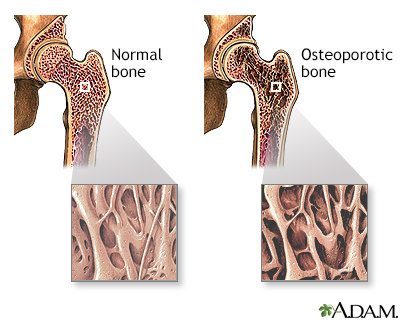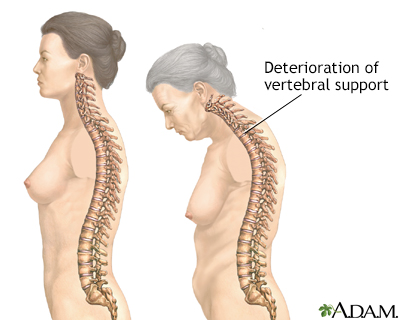Bone mineral density test
A bone mineral density (BMD) test measures how much calcium and other types of minerals are in an area of your bone.
This test helps your health care provider detect osteoporosis or bone loss and predict your risk for bone fractures.
Osteoporosis
Osteoporosis is a disease in which bones become fragile and more likely to break (fracture).

Osteoporosis - Animation
If you've ever watched an apartment or office building under construction, you've seen the metal scaffolding that keeps the building standing upright. Inside your body, bones are the scaffolding that keep you standing upright. As you get older, these supports can weaken. And if they get too weak, you could wind up with a fracture. Let's talk about the bone-thinning condition called osteoporosis. Your internal scaffolding was built when you were young. Calcium and other minerals helped strengthen your bones, provided that you got enough of them from your diet. As you get older, those minerals can start to leech out of your bones, leaving them brittle, fragile, and easily breakable, a condition known as osteoporosis. Women over 50 are especially at risk for osteoporosis because during menopause they lose estrogen, which helps to keep bones strong. The tricky part about osteoporosis is that it's hard to tell you have it. You may not have any symptoms until you've already fractured a bone. Getting a bone density scan, which measures bone thickness, is one way to find out whether you have osteoporosis so you can start treatment right away if you need it. To keep your bones strong, try to get at least 1,200 milligrams of calcium daily, paired with 1,000 international units of vitamin D, which helps your body absorb calcium. You can eat foods that are high in these nutrients, like frozen yogurt, salmon, and low-fat milk, or, if you're not a big fan of fish or dairy, you can take supplements. Weight bearing exercise is also your ally when it comes to strengthening bones. A combination of weight bearing exercises like walking or playing tennis, plus strength training and balance exercises will reduce your risk of getting a fracture if you fall. You will want to get at least thirty minutes of exercise three times a week to see the benefits. And, stop smoking. Cigarette smoke both accelerates bone loss and blocks treatments from being as affective. If you've been diagnosed with osteoporosis, your doctor may recommend drugs called bisphosphonates to prevent further bone damage. Other medicines, including calcitonin, parathyroid hormone, and raloxifene are also treatment options. Don't let bone loss get so far along that you could have a disabling fracture from a minor fall. Start strengthening your bones with diet and exercise while you're still young. As you get older, talk to your doctor about bone density scans, and ask whether you need to take medicine if you're at risk for, or are starting to show signs of osteoporosis. And if your bones aren't as strong as they used to be, avoid falls by wearing shoes that fit well, and clearing clutter on the floor before it can trip you up, and bring you down.
How the Test is Performed
Bone density testing can be done in several ways.
The most common and accurate way uses a dual-energy x-ray absorptiometry (DEXA) scan. DEXA uses low-dose x-rays. (You receive more radiation from a chest x-ray.)
x-rays
X-rays are a type of electromagnetic radiation, just like visible light. An x-ray machine sends individual x-ray waves through the body. The images...

There are two types of DEXA scans:
- Central DEXA -- You lie on a soft table. The scanner passes over your lower spine and hip. In most cases, you do not need to undress. This scan is the best test to predict your risk for fractures, especially of the hip.
- Peripheral DEXA (p-DEXA) -- These smaller machines measure the bone density in your wrist, fingers, leg, or heel. These machines are found in some health care offices, pharmacies, shopping centers, and at health fairs.
How to Prepare for the Test
If you are or could be pregnant, tell your provider before this test is done.
DO NOT take calcium supplements for 24 hours before the test.
You'll be told to remove all metal items from your body, such as jewelry and buckles.
How the Test will Feel
The scan is painless. You need to remain still during the test.
Why the Test is Performed
Bone mineral density (BMD) tests are used to:
- Diagnose bone loss and osteoporosis
- See how well osteoporosis medicine is working
- Predict your risk for future bone fractures
The US Preventive Services Task Force recommends this test for women age 65 and older and for some women younger than age 65 who have an increased risk of osteoporosis.
There is not full agreement on whether men should undergo this type of testing. Some groups recommend testing of men at age 70, while others state that the evidence is not clear enough to say whether men will benefit from screening.
Younger women, as well as men of any age, may also need bone density testing if they have risk factors for osteoporosis. These risk factors include:
- Fracturing a bone after age 50
- Strong family history of osteoporosis
- History of treatment for prostate cancer or breast cancer
- History of medical conditions such as rheumatoid arthritis, diabetes, thyroid imbalances, or anorexia nervosa
Rheumatoid arthritis
Rheumatoid arthritis (RA) is a disease that leads to inflammation of the joints and surrounding tissues. It is a long-term disease. It can also aff...
 ImageRead Article Now Book Mark Article
ImageRead Article Now Book Mark Article - Early menopause (either from natural causes or hysterectomy)
Menopause
Menopause is the time in a woman's life when her periods (menstruation) stop. Most often, it is a natural, normal body change that occurs between ag...
 ImageRead Article Now Book Mark Article
ImageRead Article Now Book Mark Article - Long-term use of medicines such as corticosteroids, thyroid hormone, or aromatase inhibitors
- Low body weight (less than 127 pounds or 57 kilograms) or low body mass index (less than 21 kilograms per square meter)
- Significant loss of height
- Long-term tobacco or excessive alcohol use
Normal Results
The results of your test are usually reported as a T-score and Z-score:
- T-score compares your bone density with that of a healthy young woman.
- Z-score compares your bone density with that of other people of your age, sex, and race.
With either score, a negative number means you have thinner bones than the comparison group. The more negative the number, the higher your risk for a bone fracture.
A T-score is within the normal range if it is -1.0 or above.
What Abnormal Results Mean
Bone mineral density testing does not diagnose fractures. Along with other risk factors you may have, it helps predict your risk for having a bone fracture in the future. Your provider will help you understand the results.
If your T-score is:
- From -1 to -2.5, you may have bone loss (osteopenia)
- Below -2.5, you likely have osteoporosis
Treatment recommendations depend on your total fracture risk. This risk can be calculated using the FRAX score. Your provider can tell you more about this. You can also find information about FRAX online.
Risks
Bone mineral density uses a slight amount of radiation. Most experts feel that the risk is very low compared with the benefits of finding osteoporosis before you break a bone.
Reviewed By
John D. Jacobson, MD, Professor Emeritus, Department of Obstetrics and Gynecology, Loma Linda University School of Medicine, Loma Linda, CA. Internal review and update on 02/06/2024 by David C. Dugdale, MD, Medical Director, Brenda Conaway, Editorial Director, and the A.D.A.M. Editorial team.
Almohaya M, Almehthel M, Kendler D. Dual x-ray absorptiometry and measurement of bone. In: Hochberg MC, Gravallese EM, Smolen JS, van der Heiide D, Weinblatt ME, Weisman MH, eds. Rheumatology. 8th ed. Philadelphia, PA: Elsevier; 2023:chap 48.
LeBoff MS, Greenspan SL, Insogna KL, et al. The clinician's guide to prevention and treatment of osteoporosis. Osteoporos Int. 2022;33(10):2049-2102. PMID: 35478046 pubmed.ncbi.nlm.nih.gov/35478046/.
US Preventive Services Task Force website. Osteoporosis to Prevent Fractures: Screening. www.uspreventiveservicestaskforce.org/uspstf/recommendation/osteoporosis-screening. June 26, 2018. Accessed February 6, 2024.
Weber TJ. Osteoporosis. In: Goldman L, Cooney KA, eds. Goldman-Cecil Medicine. 27th ed. Philadelphia, PA: Elsevier; 2024:chap 225.




 All rights reserved.
All rights reserved.